“We have to show there is profit potential in projects like these…” – Lisa Picard, Executive Vice President and Regional Manager, Skanska USA, Seattle.
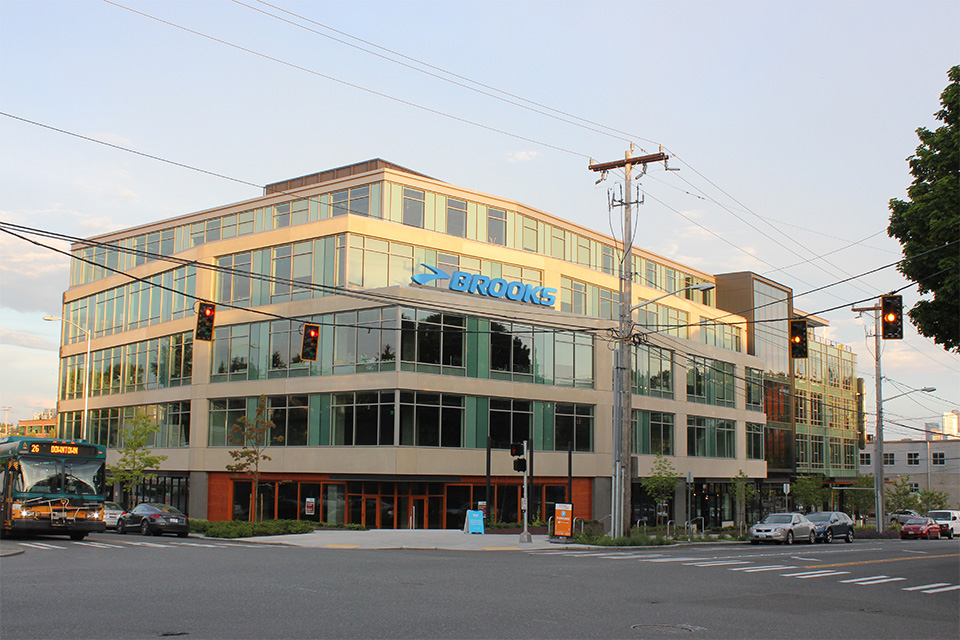
The design and location of Stone 34, the new global headquarters of Brooks, was envisaged as an urban “trailhead” to Seattle’s popular Burke-Gilman Trail. Learning that Brooks was looking to relocate from Bothell, construction group Skanska USA approached the company’s CEO and pitched the idea. The vision offered the opportunity for Brooks to connect with customers using the trail and resonated with the company’s environmental values. Brooks signed a lease based on this idea, unconventionally for a building that did not yet exist, but would become a trailblazer as the second building to participate in the City of Seattle’s Deep Green Pilot Program.
Enticing sustainable development
The City of Seattle introduced the Pilot (now Living Building Pilot Program) to alleviate barriers to developments participating in the Living Building Challenge (LBC), a rigorous green building certification program designed by the International Living Future Institute. The Pilot provides flexibility for projects attempting to meet some or all of the LBC requirements, by allowing departures from aspects of the Seattle Land Use Code which are barriers to meeting the sustainability standards. It aims to encourage projects to participate in the LBC by offering incentives such as additional building height or floor area.
A preferred site for Brooks had been found near the trail, however, a height restriction of 45 feet did not enable enough floor space. During a tour of Stone 34, Skanska USA conveyed the prospect of being allowed extra height was an added incentive for participating in the Pilot. As part of the Pilot, Stone 34 had to reduce water and energy consumption by 75% compared to a standard building and capture and reuse at least 50% of storm water on site.
Design features
By incorporating features to reduce water and energy use, encourage environmentally conscious behavior and measure environmental performance, the building acts as a billboard for Brooks by highlighting the company’s sustainability values. The project included cleaning up the contaminated site at the intersection of Stone Way North and 34th Street and salvaging wood from the demolition for reuse in a feature staircase. The building includes hydronic chilled beams which provide more efficient heating and cooling by circulating water to manage temperature. The heat recovery and exchange chiller system produces chilled water and captures wasted energy to heat water. A phase change thermal energy storage tank freezes and thaws “flat ice” bricks at 55 degrees Fahrenheit.
The building was designed by LMN Architects to optimize passive cooling and heating, however, windows are not operable due to noise and odor impacts of the adjacent transfer station. Natural lighting is maximized by large windows and complemented by LED lights with daylight and motion sensors. Rainwater is treated, stored and re-used for irrigating landscapes. The city’s water supply is used for all drinking purposes, with low flow water fixtures to minimize use. The terraces and rooftop deck offer landscaped spaces for workers to enjoy, with views over Lake Union.
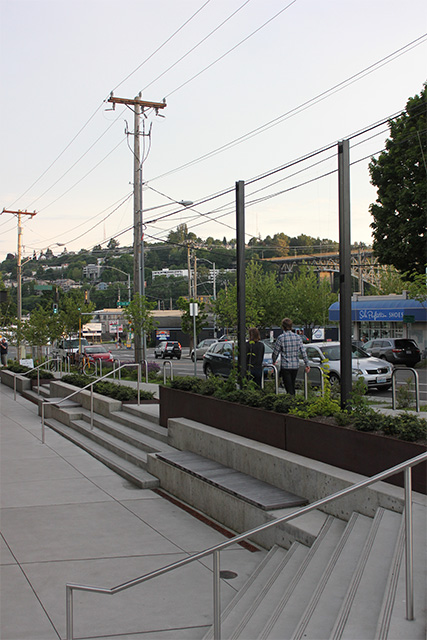
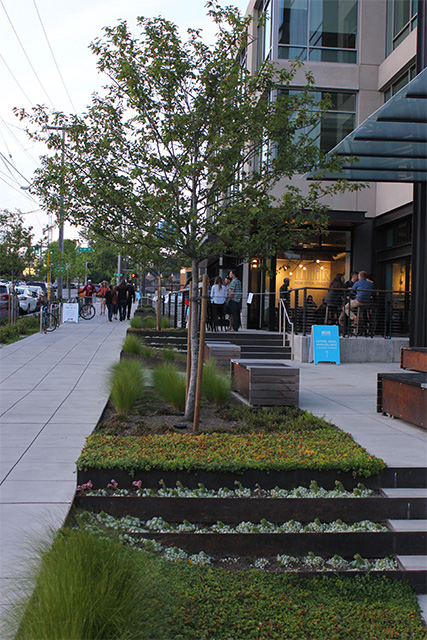
Reflecting the vision for the trailhead, design elements help connect the five-story commercial building with its local setting. Ground floor retail spaces with glass windows enable a visual connection between the building and the street. A tiered plaza, designed by Swift Company, frames the edge of the building, offering a public gathering space with seating, drinking fountains, bicycle racks, and landscaping with some trees. These features are designed for runners, walkers and cyclists passing by to use for stretching or their warm up routines. The garage includes electric vehicles charging stations and bicycle storage. Despite the area being serviced by several bus lines and the bicycle trail, Stone 34 has 216 underground car parking spaces. While this seems to be at odds with the sustainable vision, according to Skanska USA, this was important to remain commercially competitive.
Behavioral change
The majority of energy and water savings are due to the building design, however the behavior of workers is a significant component. The design process involved research of the anticipated behavior of workers to understand the likely energy and water demands. Skanska USA and Brooks developed strategies for reducing consumption through behavioral change, programming and equipment purchasing. Brooks upgraded desktop computers with more energy efficient laptops. Office lights and computers are programmed to turn off at the end of the day. People manually switch on lights or log in to computers if they are still working. Showers encourage people to cycle to work, but timeout after a few minutes.
A grand stairwell framed with energy-efficient glass is located at the entrance to encourage people to walk instead of use the elevator, fitting for a company promoting active lifestyles. A dashboard in the lobby displays water and energy consumption data to raise awareness and encourage workers to reduce their environmental footprint. The lobby also features a kinetic sculpture by Seattle artist Casey Curran in which brass flowers are programmed to subtly change position and bloom when the building consumes little energy and wilt when use is high. Both displays are visible to members of the public who enter the foyer, making the performance of Stone 34 and Brooks incredibly transparent.
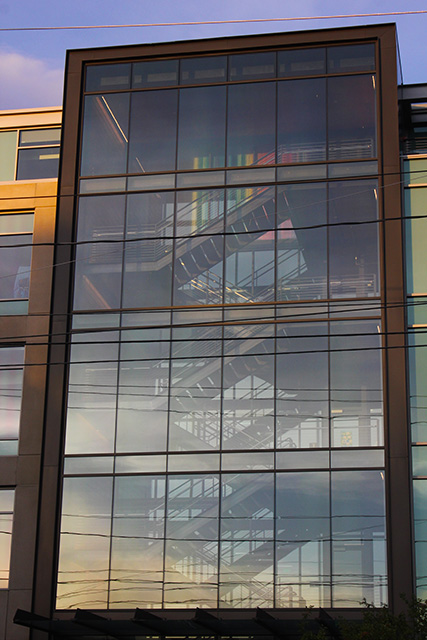
Exchanging green design for additional space
Although designed to exceed the U.S. Green Building Council’s LEED Platinum certification (the highest status), not everyone was supportive of the project. The building was subject to seven design reviews, a process which Skanska USA describes improved the project as a result of community and professional discussions. However, several reports during the application process refer to some members of the community and the sustainability sector who were not receptive to the project receiving additional height for sustainability features. The commentary reflected concerns that the additional 20 feet, ultimately granted to the project, would compromise neighborhood character and block views of Lake Union.
There were criticisms that the incentive should be offered only to projects meeting all, or more of the LBC standards. While valid considerations, the project demonstrated that the City’s Pilot and incentive approach could be successful in encouraging developments to strive for exceptional environmental performance. It is likely that until sustainable buildings become the norm, rather than the exception, incentives and waivers will need to be offered by cities.
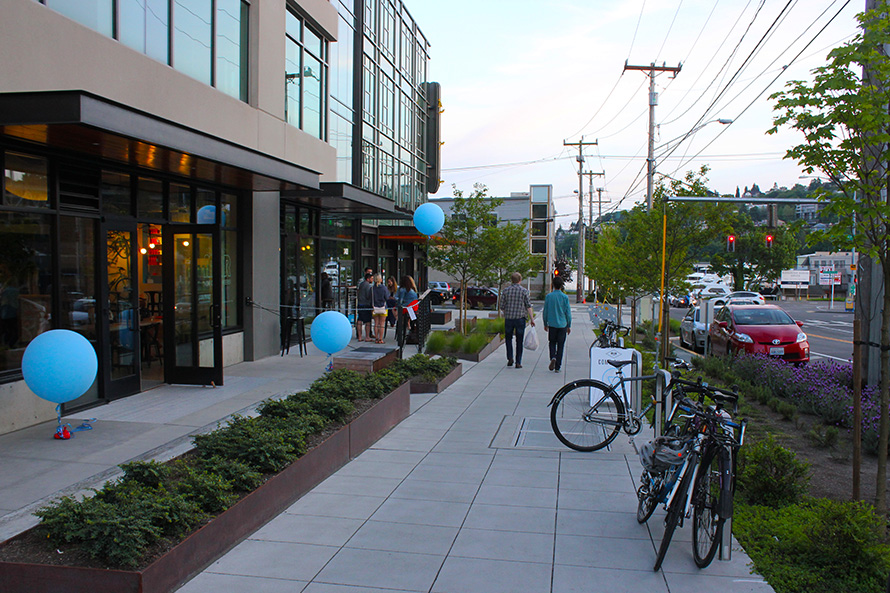
Living up to green and market expectations
The City of Seattle imposes a financial penalty if the building’s operations do not meet environmental targets once occupied. As a result, the project had to extend beyond sustainable design and influence the behavior of the 300 or so people who would work inside the building. A unique legal agreement had to be established as to who would be responsible for paying penalties in the event the environmental performance targets were not met. Both Skanska USA and Brooks agreed to share responsibility. This interestingly reflects the investment by both companies in ensuring the building operates successfully.
In July 2014, the Living Building Pilot was amended to increase the maximum penalty for projects that fail to comply with the standards from 5% to 10% of the construction costs; a substantial cost. Whilst the penalty is a powerful tool for the City to encourage the developer and tenant to deliver a building which meets environmental expectations, it also has potential to create an additional financial risk which may decrease willingness for developments to participate in the Pilot. As environmental compliance with the Pilot is assessed once buildings are occupied for a full year, Stone 34 is still in its performance period. Last year, Skanska USA sold Stone 34 and it is suggested the sale provided a significant return, demonstrating to other developers, the profit potential of green buildings.
A step in the right direction
Although Stone 34 received criticism for exceeding the original height limits and not meeting more of the LBC standards, it is significant as one of two projects to have enrolled and been built as part of the Pilot initiative. This perhaps highlights the challenges faced by private developments and their willingness in delivering green buildings. Several of the features in Stone 34 are valuable for increasing knowledge about new technologies. As one example of this, Skanska USA’s current 400 Fairview project is incorporating the hydronic system after Stone 34 demonstrated the benefits. Although some elements are less progressive, such as the number of car parking spaces, the commitment to extending environmental performance to occupant’s behavior highlights the potential for significant environmental improvements in every building, regardless of quality or age.
In 2014, Stone 34 was awarded Office Development of the Year by the Washington Chapter of the Commercial Real Estate Development Association (NAIOP). This accolade assists to send a message of the benefits of improving the environmental performance of buildings to other developers. The experience of Stone 34 perhaps indicates the importance of developing flexible green design standards and programs to encourage more developers to take these ideas on board, now that their potential profitability has been demonstrated.
This article is a cross-post from Drawn to Cities. Sarah Oberklaid is an Australian urban planner and artist based in Seattle.
Sarah is an urban planner and artist from Melbourne Australia, currently living in Seattle. She has contributed to diverse long-term projects addressing housing, transportation, community facilities, heritage and public spaces with extensive consultation with communities and other stakeholders. Her articles for The Urbanist focus on her passion for the design of sustainable, inviting and inclusive places, drawing on her research and experiences around the world.



